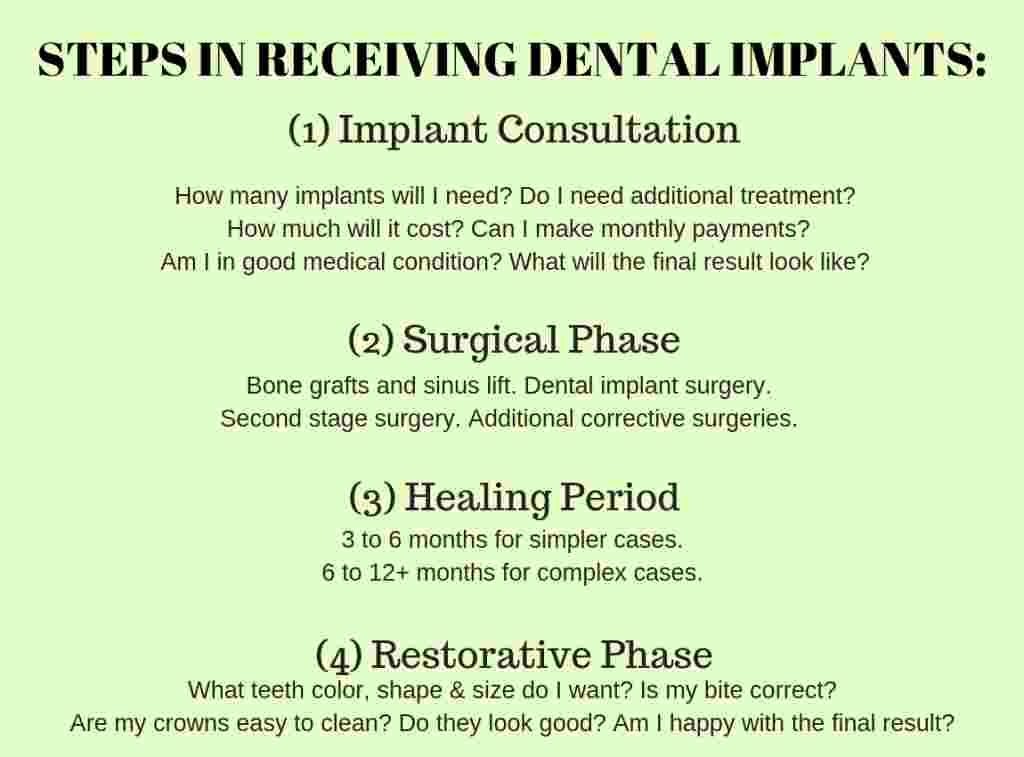What are dental implants?

A well-fabricated dental implant is indistinguishable from natural teeth.
A dental implant is an entirely fake tooth that replaces your original missing tooth. Each dental implant consists of three parts:
- Implant Fixture - The fixture is the screw which replaces your tooth root. Implant fixtures are typically made from Titanum or Zirconia.
- Implant Crown - The crown is the portion which replaces your tooth. Implant crowns are usually made from porcelain or ceramics and are either cement-retained or screw-retained.
- Abutment - The abutment connects these two pieces together. Again, abutments can be made from different metal alloys.
These three parts work together to give you a fully functional artificial tooth.
Why are dental implants so popular?

Dental implants look and function similarly to natural teeth
Dental implants offer the best option to replace your missing teeth. This is because dental implants look and function similarly to your natural teeth. If you have missing teeth, your only other options are bridges and dentures. However, neither a bridge nor a denture is nearly as good as a dental implant. Here's why:
- Only dental implants preserve your jawbone.
- Dental implants do not harm your adjacent teeth the way dentures and bridges do.
- Implants provide for 100% chewing capability, in contrast to only 20 to 40% for dentures.
- Dental implants give you the confidence of having your original teeth back.
What are the steps involved in receiving dental implants?
The dental implant process may seem a bit complicated at first. This is especially true if you're receiving your first dental implant. To better understand the process of receiving dental implants, we've divided it into four major steps, which are:
- Dental implant consultation - Your implant journey starts off with a consultation. Don't be shy and ask your dentist any questions you have about your treatment. The implant consultation is the best time to discuss your treatment to see if dental implants are right for you.
- Surgical implant phase - The surgical implant phase concentrates on placing solid implants into the jawbone. In addition to implants, many patients require a bone graft, second-stage surgery, and other corrective surgical procedures. Typically, these surgeries are performed by an oral surgeon, periodontist, or general dentist with specialized training in implant dentistry.
- Healing period - Dental implants require a healing period of several months for the dental implant fixture to integrate with your jawbone. The average healing time is about two to six months. However, healing times for more complex treatments may be up close to a year or even longer.
- Restorative phase - The restorative implant phase focuses on fabricating a functional and aesthetic tooth on top of the implant fixture. During the restorative phase, your dentist will make measurements and choose a color and shape for your final crown. This is the best time to discuss the appearance of your final tooth. Be as specific as you can and convey your expectations to your dentist clearly. Only through effective communication can your dentist give you the results you want so you can have teeth that you're going to love for many years to come.

Dental Implant Consultation
Before placing dental implants, you need to schedule a consultation appointment. During this appointment, your dentist will work with you to decide the best course of treatment. There are a lot of important decisions to be made during your implant consultation, for instance:
- How many dental implants do you need?
- What size/brand implant is suitable for my mouth?
- Do you require additional adjunct treatments such as a bone graft or a sinus lift?
- How are your remaining teeth looking and can you keep them?
- Do you have any medical conditions which may delay the healing process?
As you can see, the dental implant treatment planning process can be quite involving. This is why you may find yourself working with a group of dental specialists including periodontists, oral surgeons, and prosthodontists. Alternatively, you can find an implant specialist who performs the entire treatment. Either way, you will require a thorough evaluation to determine if you're a good candidate before implant treatment. The preparation process includes the following:
- Examination - Your dentist will require a set of X-rays to access your jawbone and vital structures. Typically, a CT scan and/or panoramic radiograph is required to examine the bone quantity and quality.
- Medical history assessment - Your dentist needs to know about all of your medical conditions as well as any medications you're currently taking. This includes over-the-counter medicine such as Aspirin and other supplements you regularly take. There are certain medical issues and medicines that interfere with blood coagulation or bone healing. It's important that your dentist knows your complete background prior to starting implant treatment.
- Teeth models - Your dentist may decide to take impressions of your teeth to fabricate study models, surgical guide, or temporary teeth.
- Treatment planning - With your X-rays and models in hand, your dentist can start treatment planning your dental implants. The treatment plan process is very important to determine how and where to place your dental implants. The more teeth you're missing, the more complex your treatment plan will be. Too few dental implants and your prosthesis could collapse under bite forces. Too many implants and your costs can skyrocket. Plus, the restoration phase can become quite cumbersome if the implants are not properly placed.
- Consent forms - There may be multiple informed consent forms that you may have to sign. This could include a consent form for tooth extraction, bone grafting, implant placement, sedation, and any other procedure that is part of your treatment plan.
- Finances - We all know that dental implants are expensive. Luckily, almost all dental implant dentists offer some sort of flexible monthly payment plan options. It's important to make sure that you can afford your treatment in advance. Otherwise, you may have to postpone treatment or receive your treatment in phases. You can also look into dentures or alternative treatment options.
Dental Implant Surgical Phase
Dental implant surgery is an outpatient procedure performed by your dentist or oral surgeon. Your surgery may take as little as one hour for a single implant, or up to half a day for a full mouth implant case. Simpler cases typically require one to two surgeries. More complex cases could require multiple surgeries including implant placement surgery, bone grafting, second-stage surgery, corrective surgeries, etc. This all depends on the complexity of your treatment as follows:
- Single tooth implant - Single tooth replacements are the simplest cases to treat so long as you don't run into any complications. Typically, the broken tooth has to be removed and the area needs to be packed with bone graft. A dental implant fixture is inserted when the area is ready. This process typically takes two to three visits over the course of several months. Occasionally, tooth extraction, bone graft, and implant placement can all be done during one session if your dentist is experienced with immediate implant placement.
- Multiple tooth implant - These cases can sometimes be similar to a single tooth implant case. However, it's not uncommon to need a bone grafting or sinus augmentation procedure. This would add an additional surgery or two and a few months to your treatment times.
- All-on-four dental implants - All-on-four dental implant surgery is only performed by experienced dentists and oral surgeons. Typically, all of your dental implants are placed in one surgery.
- Implant-supported dentures - The surgery for overdentures, or implant-supported dentures, is performed during a single surgical visit. The overdenture surgery is far simples than all-on-four surgery since you can pretty much place the implant anywhere. Also, most dentists use skinnier implants, known as mini implants, which are easier to use and work with.
Healing Period
Following the surgical implant phase, you have to wait for the implants to heal before receiving your teeth. Dental implant healing occurs through a process known as osseointegration which refers to bone growth into the implant screw. If an implant is loaded too early, before it has had a chance to osseointegrate, it will fail. This is why it's important to wait until your dental implant has properly healed before restoring it. Typically, dental implants need three to six months to complete their osseointegration.
Dental Implant Restorative Phase
Once your dental implant has healed, it is now time to receive your final teeth. The position of implant crowns is determined based on your bite as well as the remaining teeth. Implant crowns are placed in the ideal position to maximize chewing and esthetic results. There are several different techniques dentists use to fabricate implant crowns. Regardless of the technique, you will receive your abutments and crowns require a few visits to fabricate. Your dentist will discuss the material and design for your final abutment and implant crown. There are two major types of crowns used to restore dental implants, which are:
- Screw-retained crowns - This is a one-piece abutment and crown where the whole prosthesis gets screwed into the implant fixture. Screw-retained crowns are a better option for more complex cases, heavy grinders, and when lacking sufficient restorative space. These crowns can also be easily removed if there ever is a need.
- Cement-retained crowns - These crowns get glued on top of the implant to the abutment. Cement-retained crowns look great, slightly better than screw-retained ones, since they don't have a screw access hole on them. This makes them an ideal choice for restoring cosmetic dental implants on the front teeth. However, cement-retained crowns can not be retrieved as easily and the crown may also fall off from the abutment if the cement were to fail.
Hopefully, you now have a better understanding of how the implant process. If you have any other questions be sure to talk to your dentist about it.

0 Comments